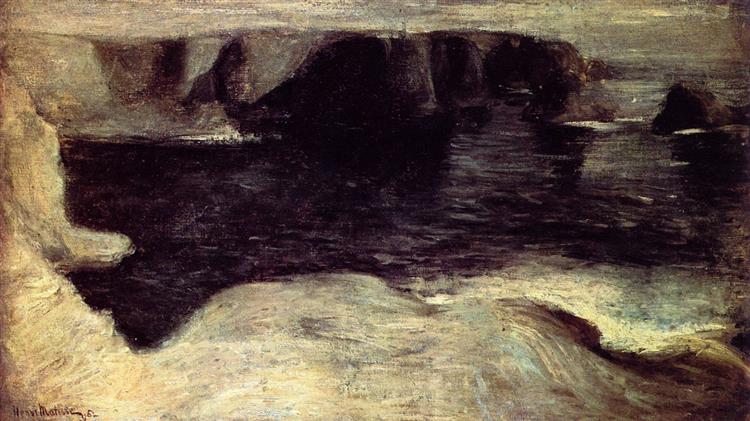Description
Henri Matisse, one of the fundamental pillars of modern art, created in 1896 a work that, although it may seem at first glance another exercise in impressionism, reveals in its depth the seeds of a highly personal style that would later come to revolutionize 20th-century painting. "Seascape at Goulphar" (1896), more than a mere seascape, is a window into the artistic transition of a young Matisse, who was navigating the still turbulent seas of tradition and innovation.
The painting is a serene and powerful vision of the sea at Goulphar, a coastal area of Belle-Île-en-Mer, in the Brittany region of France. The choice of location is no coincidence, as Belle-Île had been a popular destination among impressionist painters, including Claude Monet, who also immortalized the region in numerous works. In that 75x43 canvas, far from falling into the repetition of his predecessors, Matisse imbues the scene with a unique and vibrant atmosphere.
The painting, despite being created at the beginning of Matisse's career, foreshadows a color palette that would be distinctive in his future works. The play of green, blue, and brown tones, applied in a style that flirts with chromatic synthesis and abstraction, anticipates the bold use of color that would characterize Fauvism, the movement of which Matisse would be the undisputed leader years later.
The compositional structure of "Seascape at Goulphar" is dominated by a vast and clear sky that meets an equally vast ocean. The movement of the water, subtly captured with quick and effective brushstrokes, imparts dynamism to the scene. Here is where the influences of artists like Georges Seurat and Paul Signac can be perceived, whose pointillism and divisionist colors seem to have left a mark on Matisse's technique. However, where Seurat employed minutiae, Matisse uses large planes of color, foreshadowing his evolution towards greater formal simplification and an exaltation of pure color.
Upon closer examination of the work, one can notice the absence of human figures, which reinforces the connection between the viewer and nature, without intermediaries to distract from the elemental force of the landscape. This minimalism in the scene, though pragmatic, endows the work with an emotional intensity that resonates in the solitude and magnificence of the natural environment.
Another notable aspect is Matisse's brushstroke, loose and vigorous, conveying a sense of immediacy and spontaneity. This style suggests a momentary, almost photographic capture of the landscape, and reflects a constant exploration by the artist of the expressive possibilities of the pictorial medium. The horizon, slightly blurred, shows an expert handling of the transition between sky and sea, demonstrating a delicacy in the balance of elements that only a master in training could execute with such precision.
It is important to highlight that "Seascape at Goulphar" should be understood not only as a standalone work but also in the context of Matisse's artistic evolution. In later pieces such as "Luxe, Calme et Volupté" (1904), the development of techniques and styles suggested in "Seascape at Goulphar" can be clearly observed, showing us a Matisse who, even in his youth, possessed a clear vision and an innate talent for pictorial creation.
In summary, "Seascape at Goulphar" is a work that encapsulates a crucial moment in Henri Matisse's artistic quest, where nature is not only the subject but also the medium through which the young painter experiments and discovers the expressive capabilities of color and form. This piece, seemingly tranquil, is actually a tumultuous symphony of contained innovation, a revealing prelude to the genius Matisse was destined to be.

